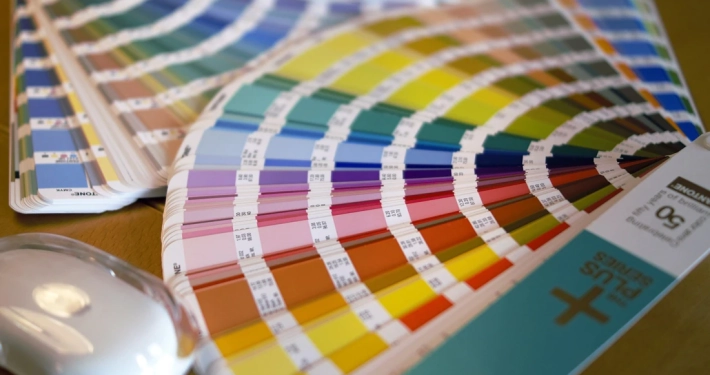Pantone palette colors on labels
An important part of a well-crafted label is the use of appropriate colors. To achieve this effect, the self-adhesive label industry offers the possibility to go beyond the standard CMYK by using the Pantone palette.
What is the Pantone palette?
The printing industry has been using CMYK for years, where any shade can be created from a mixture of Cyan, Magenta, Yellow and Black. The American company Pantone LLC of Carlstadt, New Jersey, has developed and released its own color standard, which is known as the Pantone Palette (PMS). Each color tone is marked with a number (e.g. 485C) and an additional description (metallicity or fluorescence). There are as many as 1761 colors in the basic set, obtained by mixing appropriate pigments. Pantone colors are characterised by a higher intensity and clarity of color. Thanks to the possibility of using additional series i.e. metallic or fluorescent colors, the designs can become a unique product that catches consumers’ attention.
Pantone template in printing
Accurately replicating the Pantone palette on CMYK and RGB scales is not easy. In practice, this means that a standard printout may differ in color from what the designer sees on the computer monitor.
For labels or other advertising materials to be a coherent whole, and for their colors to meet specific requirements, it is necessary to obtain a certified Pantone template, which is used as an aid in selecting the appropriate shades for projects.
Professional graphic studios and advertising agencies use Pantone templates matched to specific printing substrates, which are a standard solution thanks to which it is possible to match colors used in the design of logos, labels or packaging.
– Formula Guide Coated – coated surfacea;
– Formula Guide Uncoated¬- uncoated surface;
– Formula Guide Matte – matte surface;
– Color Bridge Coated Euro – a Pantone and CMYK scale comparison that allows you to make a direct comparison of how Pantone colors will look when printed in CMYK mode on coated paper.
– 4-colorProcess Guide Coated – shows CMYK color percentages for a given Pantone shade, coated surface,
– 4-colorProcess Guide Uncoated- shows CMYK color percentages for a given Pantoneshade¬, uncoated surface.
Pantone labels – why use Pantone palette colors?
The scale developed by the American company Pantone LLC includes many colors in different tones (glossy, matte, etc.) giving designers the opportunity to create unique designs of labels and packaging, so that the product will have a chance to stand out from many similar products. It is worth noting that when creating labels or packaging, attention should be paid to maintaining coherence between the project and the visual identification of the brand. The use of exactly the same colors on subsequent copies enables perfect reproduction of the logo and other distinctive elements. Pantone Palette inks must meet strict standards, so they almost always produce the exact same shade. Pantone labels allow you to maintain perfect color on subsequent batches.
Pantone shrink sleeve and self-adhesive labels – check our offer!
In Aniflex Printing House we use modern machines and printing technologies, which allow us to put on self-adhesive labels any colors from Pantone palette. Check out the details of our offer and order materials that will allow you to maintain a uniform color scheme for all your projects.
Feel free to contact us – an experienced advisor will answer any question.

